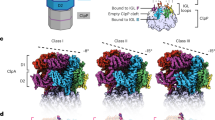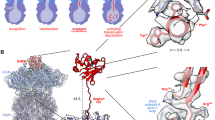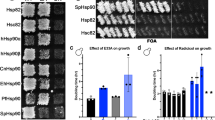Abstract
ATP-dependent protein degradation is controlled principally by substrate recognition. The AAA+ HslU ATPase is thought to bind protein substrates, denature them, and translocate the unfolded polypeptide into the HslV peptidase. The lack of well-behaved high-affinity substrates for HslUV (ClpYQ) has hampered understanding of the rules and mechanism of substrate engagement. We show that HslUV efficiently degrades Arc repressor, especially at heat-shock temperatures. Degradation depends on sequences near the N terminus of Arc. Fusion protein and peptide-binding experiments demonstrate that this sequence is a degradation tag that binds directly to HslU. Strong binding of this tag to the enzyme requires ATP and Mg2+. Furthermore, fusion of this sequence to a protein with marked mechanical stability leads to complete degradation. Thus, these experiments demonstrate that HslUV is a powerful protein unfoldase and that initial substrate engagement by the HslU ATPase must occur after ATP binding.
This is a preview of subscription content, access via your institution
Access options
Subscribe to this journal
Receive 12 print issues and online access
$209.00 per year
only $17.42 per issue
Buy this article
- Purchase on SpringerLink
- Instant access to full article PDF
Prices may be subject to local taxes which are calculated during checkout





Similar content being viewed by others
References
Gottesman, S. Proteolysis in bacterial regulatory circuits. Annu. Rev. Cell Dev. Biol. 19, 565–587 (2003).
Chiba, S., Akiyama, Y., Mori, H., Matsuo, E. & Ito, K. Length recognition at the N-terminal tail for the initiation of FtsH-mediated proteolysis. EMBO Rep. 1, 47–52 (2000).
Bochtler, M., Ditzel, L., Groll, M. & Huber, R. Crystal structure of heat shock locus V (HslV) from Escherichia coli. Proc. Natl. Acad. Sci. USA 94, 6070–6074 (1997).
Bochtler, M. et al. The structures of HslU and the ATP-dependent protease HslU-HslV. Nature 403, 800–805 (2000).
Sousa, M.C., Kessler, B.M., Overkleeft, H.S. & McKay, D.B. Crystal structure of HslUV complexed with a vinyl sulfone inhibitor: corroboration of a proposed mechanism of allosteric activation of HslV by HslU. J. Mol. Biol. 318, 779–785 (2002).
Sousa, M.C. et al. Crystal and solution structures of an HslUV protease–chaperone complex. Cell 103, 633–643 (2000).
Song, H.K. et al. Mutational studies on HslU and its docking mode with HslV. Proc. Natl. Acad. Sci. USA 97, 14103–14108 (2000).
Wang, J. et al. Nucleotide-dependent conformational changes in a protease-associated ATPase HslU. Structure 9, 1107–1116 (2001).
Trame, C.B. & McKay, D.B. Structure of Haemophilus influenzae HslU protein in crystals with one-dimensional disorder twinning. Acta Crystallogr. D 57, 1079–1090 (2001).
Rohrwild, M. et al. The ATP-dependent HslUV protease from Escherichia coli is a four-ring structure resembling the proteasome. Nat. Struct. Biol. 4, 133–139 (1997).
Kanemori, M., Nishihara, K., Yanagi, H. & Yura, T. Synergistic roles of HslVU and other ATP-dependent proteases in controlling in vivo turnover of sigma32 and abnormal proteins in Escherichia coli. J. Bacteriol. 179, 7219–7225 (1997).
Missiakas, D., Schwager, F., Betton, J.-M., Georgopoulos, C. & Rania, S. Identification and characterization of HslV HslU (ClpQ ClpY) proteins involved in overall proteolysis of misfolded proteins in Escherichia coli. EMBO J. 15, 6899–6909 (1996).
Wu, W.-F., Zhou, Y. & Gottesman, S. Redundant in vivo proteolytic activities of Escherichia coli Lon and the ClpYQ (HslUV) protease. J. Bacteriol. 181, 3681–3687 (1999).
Chuang, S. & Blattner, F.R. Characterization of twenty-six new heat shock genes of Escherichia coli. J. Bacteriol. 175, 5242–5252 (1993).
Seong, I.S., Oh, J.Y., Yoo, S.J., Seol, J.H. & Chung, C.H. ATP-dependent degradation of SulA, a cell division inhibitor, by the HslUV protease in Escherichia coli. FEBS Lett. 456, 211–214 (1999).
Nishii, W. & Takahashi, L. Determination of the cleavage sites in SulA, a cell division inhibitor, by the ATP-dependent HslVU protease from Escherichia coli. FEBS Lett. 553, 351–354 (2003).
Kwon, A.R., Trame, C.B. & McKay, D.B. Kinetics of protein substrate degradation by HslUV. J. Struct. Biol. 146, 141–147 (2004).
Waldburger, C.D., Schildbach, J.F. & Sauer, R.T. Are buried salt bridges important for protein stability and conformational specificity? Nat. Struct. Biol. 2, 122–128 (1995).
Carrion-Vazquez, M. et al. Mechanical and chemical unfolding of a single protein: a comparison. Proc. Natl. Acad. Sci. USA 96, 3694–3699 (1999).
Kenniston, J.A., Baker, T.A., Fernandez, J.M. & Sauer, R.T. Linkage between ATP consumption and mechanical unfolding during the protein processing reactions of an AAA+ degradation machine. Cell 114, 511–520 (2003).
Breg, J.N., Opheusden, J.H.v., Burgering, M.J., Boelens, R. & Kaptein, R. Structure of Arc repressor in solution: evidence for a family of β-sheet DNA-binding proteins. Nature 346, 586–589 (1990).
Milla, M.E. & Sauer, R.T. Critical side-chain interactions at a subunit interface in the Arc repressor dimer. Biochemistry 34, 3344–3351 (1995).
Burgering, M.J.M., Hald, M., Boelens, R., Breg, J.N. & Kaptein, R. Hydrogen exchange studies of the Arc repressor: evidence for a monomeric folding intermediate. Biopolymers 35, 217–226 (1995).
Schlieker, C. et al. Substrate recognition by the AAA+ chaperone ClpB. Nat. Struct. Mol. Biol. 11, 607–615 (2004).
Siddiqui, S.M., Sauer, R.T. & Baker, T.A. Role of the processing pore of the ClpX AAA+ ATPase in the recognition and engagement of specific protein substrates. Genes Dev. 18, 369–374 (2004).
Sondek, J., Lambright, D.G., Noel, J.P., Hamm, H.E. & Sigler, P.B. GTPase mechanism of G proteins from the 1.7-Å crystal structure of transducin α•GDP•AlF4−. Nature 372, 276–279 (1994).
Ishii, Y. et al. Regulatory role of C-terminal residues of SulA in its degradation by Lon protease in Escherichia coli. J. Biochem. 127, 837–844 (2000).
Kwon, A.R., Kesseler, B.M., Overkleeft, H.S. & McKay, D.B. Structure and reactivity of an asymmetric complex between HslV and I-domain deleted HslU, a prokaryotic homolog of the eukaryotic proteasome. J. Mol. Biol. 330, 185–195 (2003).
Levchenko, I., Seidel, M., Sauer, R.T. & Baker, T.A. A specificity-enhancing factor controls substrate delivery to the ClpXP degradation machine. Science 289, 2354–2356 (2000).
Milla, M.E., Brown, B.M., Waldbuger, C.D. & Sauer, R.T. P22 Arc repressor: transition state properties inferred from mutational effects on the rates of protein unfolding and refolding. Biochemistry 39, 12494–12502 (1995).
Bowie, J.U. & Sauer, R.T. Equilibrium dissociation and unfolding of the Arc repressor dimer. Biochemistry 28, 7139–7143 (1989).
Kim, Y.-I., Burton, R.E., Burton, B.M., Sauer, R.T. & Baker, T.A. Dynamics of substrate denaturation and translocation by the ClpXP degradation machine. Mol. Cell 5, 639–648 (2000).
Burton, R.E., Siddiqui, S.M., Kim, Y.-I., Baker, T.A. & Sauer, R.T. Effects of protein stability and structure on substrate processing by the ClpXP unfolding and degradation machine. EMBO J. 20, 3092–3100 (2001).
Lee, C., Schwartz, M.P., Prakash, S., Iwakura, M. & Matouschek, A. ATP-dependent proteases degrade their substrates by processively unraveling them from the degradation signal. Mol. Cell 7, 627–637 (2001).
Kenniston, J.A., Burton, R.E., Siddiqui, S.M., Baker, T.A. & Sauer, R.T. Effects of local protein stability and the geometric position of the substrate degradation tag on the efficiency of ClpXP denaturation and degradation. J. Struct. Biol. 146, 130–140 (2004).
Schildbach, J.F., Milla, M.E., Jeffrey, P.D., Raumann, B.E. & Sauer, R.T. Crystal structure, folding, and operator binding of the hyperstable Arc repressor mutant PL8. Biochemistry 34, 1405–1412 (1995).
Robinson, C.R. & Sauer, R.T. Striking stabilization of Arc repressor by an engineered disulfide bond. Biochemistry 39, 12494–12502 (2000).
Bolon, D.N., Grant, R.A., Baker, T.A. & Sauer, R.T. Nucleotide-dependent substrate handoff from the SspB adaptor to the AAA+ ClpXP protease. Mol. Cell 16, 343–350 (2004).
Singh, S.K., Grimaud, R., Hoskins, J.R., Wickner, S. & Maurizi, M.R. Unfolding and internalization of proteins by the ATP-dependent proteases ClpXP and ClpAP. Proc. Natl. Acad. Sci. USA 97, 8898–8903 (2000).
Gottesman, S., Roche, E., Zhou, Y. & Sauer, R.T. The ClpXP and ClpAP proteases degrade proteins with carboxy-terminal peptide tails added by the ssrA-tagging system. Genes Dev. 12, 1338–1347 (1998).
Acknowledgements
We thank J. Flynn and S. Siddiqui for materials and assistance with experiments and members of the Baker and Sauer labs for advice and comments. This work was supported by US National Institutes of Health grants AI-15706 and AI-16892. T.A.B. is an employee of the Howard Hughes Medical Institute.
Author information
Authors and Affiliations
Corresponding author
Ethics declarations
Competing interests
The authors declare no competing financial interests.
Rights and permissions
About this article
Cite this article
Burton, R., Baker, T. & Sauer, R. Nucleotide-dependent substrate recognition by the AAA+ HslUV protease. Nat Struct Mol Biol 12, 245–251 (2005). https://doi.org/10.1038/nsmb898
Received:
Accepted:
Published:
Issue Date:
DOI: https://doi.org/10.1038/nsmb898



